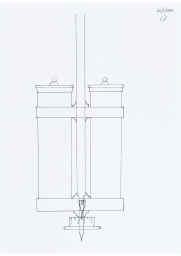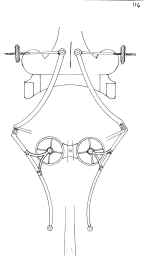Current Projects, Page Two Maker, Unknown. Most likely a 'one off' exhibition or 'engineer's' piece of English origin, c. late 1800's. Brass and bronze hybrid flat bed frame design. Hour strike using rack and snail system with quarter strike using a count wheel. Originally a three legged gravity escape with jeweled pallets (later changed to four). Pendulum, dial, hands and weights were missing. Eight day duration. 27"w x 22"h x 11.25"d. Restoration work performed by the firm Buchanan of Chelmsford. Click on individual photos for more pictures and information. The history of this small tower clock is unknown. A close inspection indicates that it was never in a permanent running condition, perhaps never actually running at all. Over time, it went derelict and fell into the hands of several 'repairers', bordering on vandals. The original fabricator who fashioned the frames and wheels showed a high degree of skill. Wheel work displays classical English design in that the hoop and spoke profiles are relatively thin compared to their width. The other outstanding feature is the very high tooth and pinion counts found throughout. The central going (time) train has six wheels with the following counts: Great wheel 96 teeth, Second wheel 120 teeth and 24 pinion leaves , Third wheel (center)112 teeth and 20 pinion leaves, Forth wheel 96 teeth and 16 pinion leaves, Fifth wheel 90 teeth and 16 pinion leaves, Escape wheel 3 teeth and 9 pinion leaves. While the machining was first rate, the casting process was not. The main wheel of the quarter strike train has a very large open void straddling the surface of the teeth making it's operation under normal loads unlikely. Several other wheels have smaller, but significant open voids. These are so large and obvious that it is a mystery as to why the original maker went ahead with the fabrication of the wheel to it's completion. The escapement has suffered under the hands of repairer/vandals and is useless in it's present form. Originally it was equipped with white stone (perhaps agate) pallets since changed to ruby. Apart from the movement plates and wheel work the rest of the clock appears to have been made by a different, far less experienced hand. The fly fans are so crudely made as to be difficult to associate with the rest of the movement. Maybe the originals were lost or never made. These appear to be completely makeshift. Perhaps as an experiment to get the clock working. The frame shows several unfilled holes where the fans were tried in one and then another position. After initial tooth counts and experimentation it was found that 40 lb. was needed to drive the going train on a simple drop. The strike trains, 70 lb. each. For a typical large tower clock these numbers are not unusual. But for such a small clock it is huge. If this was a non-descript movement meant to be hidden in a tower, then one might be able to understand the design. However, it is obvious that this clock was meant to be seen, and thus a large drop was not originally planned. As it turns out, at a comfortable viewing height, the time train can only function for four days, the strike trains two; using a simple drop. Compounding would have entailed a doubling of the weights which I deemed too much. Given the outstanding features and this movement's great potential, I decided to have extensive renovations performed by the firm Buchanan of Chelmsford, whose work has been featured in the covers of the Horological Journal, October 2003 and April 2006. This firm has also been commissioned to build a complex astronomical skeleton clock and you can watch it's construction over the next 3 years beginning early 2007.
|






